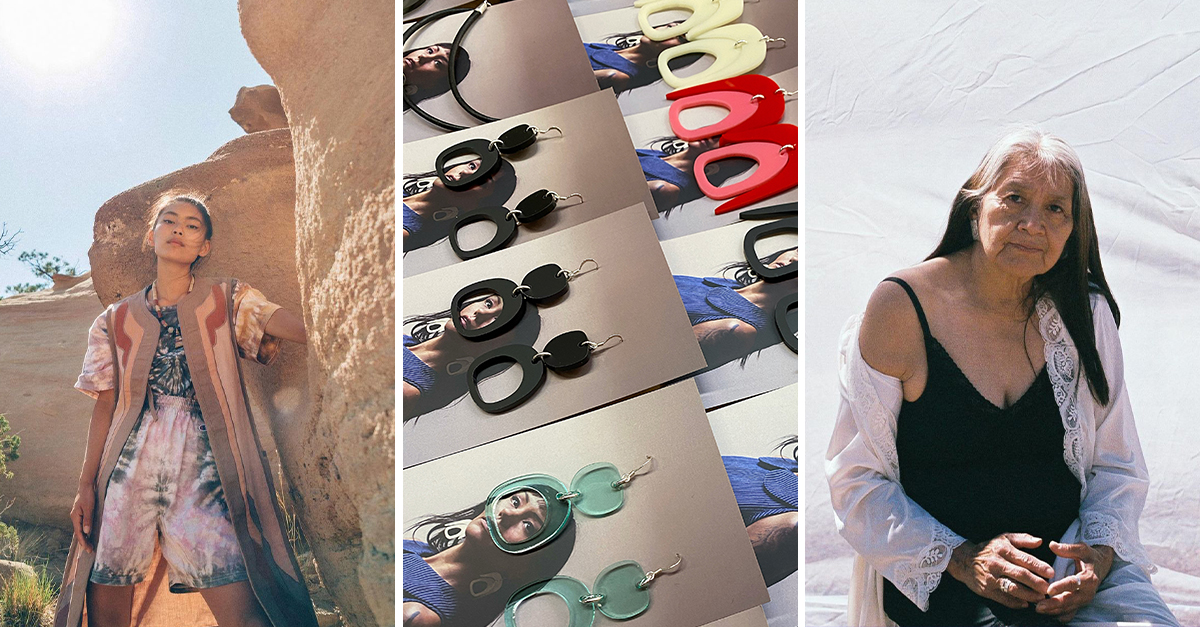7 Beautiful Native-Owned Fashion Brands to Know and Love
What is your full name and to which tribe are you affiliated?
Korina Emmerich. I am part of the Puyallup tribe.
How would you describe your brand to someone who’s not familiar?
I built my Brooklyn-based brand, Emme, on the backbone of expression, art, and culture. Leading the charge to embrace art and design as one and weaving it into her brand story. My colorful work is known to reflect my indigenous heritage stemming from The Coast Salish Territory, Puyallup tribe. With a strong focus on social and climate justice, we speak out about industry responsibility and accountability: working actively to expose and dismantle systems of oppression and challenge colonial ways of thinking.
Items are made-to-order in our Brooklyn, New York studio located on occupied Canarsie territories. Most items are made from upcycled, recycled, and all-natural materials giving respect to the life cycle of a garment from creation to biodegradation. Supplies are limited.
What influenced you to start your brand?
I am blessed to come from a really creative family. My father was an art teacher while I was growing up and I knew from a young age I wanted to be an artist, but I was still exploring what my medium would be.
The glamour of the ’90s designers still resonates with me, watching the art-driven fashion from some of the greats. I plastered my walls with images of McQueen, Versace, Gucci, etc. I wanted so badly to be a part of that world, to leave myself behind and mold into this glamorous lifestyle that seemed beyond unattainable for a child like me.
The first fully completed garment I made was my Jingle Dress Regalia in the 9th grade. The Jingle Dress, also known as the healing dress or prayer dress, is composed of a colorful foundation with rolled tobacco lids that create jingles. When you dance, each jingle has a dedicated prayer associated with it, and the sound of the jingles release the prayers. It was during the creation of this Regalia that I knew I wanted fashion to be my medium.
Emme was born out of a desire to create an elevated visual representation of my multitude of inspirations combining my indigenous and contemporary art influences. While keeping the brand focused on ethics and sustainability.
The principal statement I keep at the forefront of Emme is “The success of one is not worth the detriment of many.”
Has your indigenous background influenced your approach to jewelry and design? If so, how?
I believe indigenous designers are innately sustainable because we were raised to have a stronger connection to the earth and what it provides. I’ve always been taught not to take more than you need. To always consider future generations with every action or inaction you take. We have an understanding of the Earth’s ecology, coexistence, and dependence of all living things, summed up in the term “all my relations”. Recognizing the principles of equality, harmony, and unity, we inherently created the idea of “no waste” in common traditional practices like hunting and fishing: using every part of an animal to provide food, clothing, tools, etc. Everything the earth provides is received with the utmost respect and gratitude.
How do you hope your brand gives back to your community?
During this time Emme has been matching donations for communities in need, as well as working to allocate masks and PPE to elders and community members.
I, myself, work within the Indigenous Kinship Collective, a community of indigenous women, femmes, and gender non-conforming folx who gather on occupied Lenapehoking (NYC) to honor each other and our relatives through art, activism, education, and representation.
We work to support our communities through Mutual Aid initiatives, fund allocation, direct action, and distribution of goods.
For all the latest fasion News Click Here

